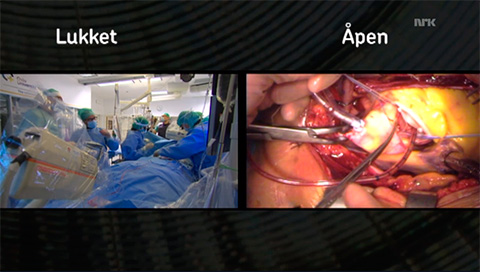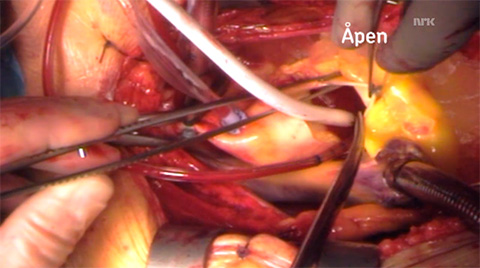December 16th, 2012
A Compelling Cardiac Surgery Broadcast — in Norway
Øystein Horgmo, BSc
This material has been imported, with permission, from The Sterile Eye.

- Screenshot from nrk.no.
Last week in Norway, surgical and percutaneous aortic valve replacements were broadcast in their entirety on television. This is the full-length feature the Norwegian Broadcasting Corporation (NRK) offered their viewers last week. And it turned out to be a night of public education on the complexities of surgery.

- The “closed” minimally invasive procedure. Screenshot from nrk.no.
The two aortic valve replacements were both done at Oslo University Hospital. The traditional open surgery and the minimally invasive TAVR (“closed”) procedure had been recorded in their entirety by the NRK. In the broadcast, they were shown side by side with the focus alternating between them at different key points.

- Studio discussion. Screenshot from nrk.no.
NRK’s stroke of genius was to have a live running commentary, or rather a conversation, in the studio between the hostess and a senior cardiac surgeon. That was a much better solution for the wide viewing audience, rather than having the surgeons comment as they were operating. The hostess asked questions most lay people would wonder about, such as “Doesn’t the guidewire hurt the blood vessels?” and “What was it like to cut through a sternum for the first time?” The surgeon in the studio answered in a nonacademic way, not afraid to address problems or difficult subjects.

- The open procedure. Screenshot from nrk.no.
An interesting thing, which I didn’t see coming, was that the program explored the pros and cons of both minimally invasive and open procedures. My feeling is that the general public tends to view minimally invasive procedures as “better” and safer than open procedures. However, the surgeons had great difficulty placing the guidewires and pacemaker in the percutaneous procedure, whereas during open surgery the work was swift and without delay. The advantage of the open field was quite clear to anyone who watched. It’s a function of the two patients who were chosen, of course, but nonetheless a good illustration of the complexities involved in choosing one procedure versus the other.
The program is in Norwegian, but for those of you who would like to watch it anyway, check out the links to some of the key moments in the two operations below — or watch the entire show here.
